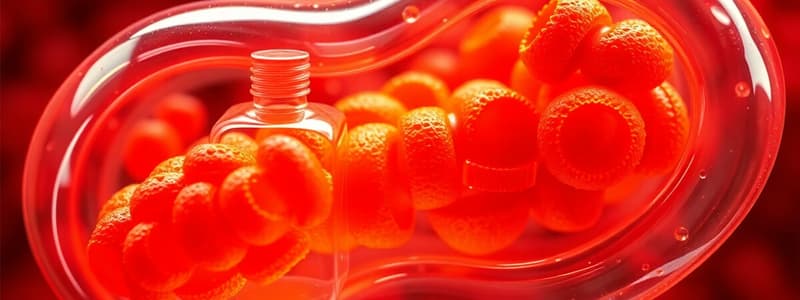Podcast
Questions and Answers
What is the end product of lactic acid fermentation?
What is the end product of lactic acid fermentation?
- Lactic Acid (correct)
- Ethanol
- Carbon Dioxide
- Pyruvate
Anaerobic respiration produces more ATP than aerobic respiration.
Anaerobic respiration produces more ATP than aerobic respiration.
False (B)
What is the primary process through which glycolysis occurs?
What is the primary process through which glycolysis occurs?
Breakdown of glucose into pyruvate
Alcoholic fermentation is primarily used in the production of ______ and baking.
Alcoholic fermentation is primarily used in the production of ______ and baking.
Match the type of fermentation with its respective end products:
Match the type of fermentation with its respective end products:
Flashcards are hidden until you start studying
Study Notes
Anaerobic Respiration
- Definition: A metabolic process that occurs without oxygen, producing energy by breaking down glucose.
Lactic Acid Fermentation
- Process:
- Occurs in muscle cells and some bacteria.
- Converts glucose to pyruvate via glycolysis, then pyruvate is reduced to lactic acid.
- Equation:
- Glucose → Lactic Acid + Energy (ATP).
- Significance:
- Provides quick energy during intense exercise.
- Can lead to muscle fatigue due to lactic acid accumulation.
Alcoholic Fermentation
- Process:
- Occurs in yeast and some bacteria.
- Converts glucose to pyruvate via glycolysis, then converts pyruvate to ethanol and carbon dioxide.
- Equation:
- Glucose → Ethanol + Carbon Dioxide + Energy (ATP).
- Applications:
- Used in brewing, baking, and wine production.
Comparison to Aerobic Respiration
- Oxygen Requirement:
- Anaerobic: Does not require oxygen.
- Aerobic: Requires oxygen.
- Efficiency:
- Anaerobic: Produces 2 ATP per glucose molecule.
- Aerobic: Produces up to 36-38 ATP per glucose molecule.
- End Products:
- Anaerobic: Lactic acid or ethanol.
- Aerobic: Carbon dioxide and water.
Energy Production
- Yield:
- Anaerobic respiration yields less energy than aerobic respiration.
- ATP Generation:
- Primary energy source in the absence of oxygen.
- Essential for short bursts of high-intensity energy.
Glycolysis
- Overview:
- First step in both anaerobic and aerobic respiration.
- Occurs in the cytoplasm.
- Process:
- Breaks down one glucose molecule into two molecules of pyruvate.
- Produces a net gain of 2 ATP and 2 NADH.
- Importance in Anaerobic Respiration:
- Provides the pyruvate that is further processed in either lactic acid or alcoholic fermentation.
Anaerobic Respiration
- Definition: A metabolic process in which energy is produced by breaking down glucose without oxygen.
- Example: Lactic acid fermentation occurs in muscle cells during intense exercise and in some bacteria.
- Example: Alcoholic fermentation occurs in yeast and some bacteria.
Lactic Acid Fermentation
- Process: Glucose is converted to pyruvate through glycolysis, and pyruvate is then reduced to lactic acid.
- Equation: Glucose → Lactic Acid + Energy (ATP)
- Significance: Provides a quick source of energy during intense exercise, but can lead to muscle fatigue due to lactic acid accumulation.
Alcoholic Fermentation
- Process: Glucose is converted to pyruvate through glycolysis, and pyruvate is then converted to ethanol and carbon dioxide.
- Equation: Glucose → Ethanol + Carbon Dioxide + Energy (ATP)
- Applications: Used in brewing, baking, and winemaking.
Comparison to Aerobic Respiration
- Oxygen Requirement: Anaerobic respiration does not require oxygen, while aerobic respiration does.
- Efficiency: Anaerobic respiration is less efficient than aerobic respiration, producing only 2 ATP per glucose molecule, compared to 36-38 ATP in aerobic respiration.
- End Products: Anaerobic respiration produces either lactic acid or ethanol, while aerobic respiration produces carbon dioxide and water.
Energy Production
- Yield: Anaerobic respiration yields less energy than aerobic respiration.
- ATP Generation: Anaerobic respiration is a primary energy source in the absence of oxygen, essential for short bursts of high-intensity energy.
Glycolysis
- Overview: The first step in both anaerobic and aerobic respiration, occurring in the cytoplasm.
- Process: Breaks down one glucose molecule into two pyruvate molecules, producing a net gain of 2 ATP and 2 NADH.
- Importance in Anaerobic Respiration: Glycolysis provides the pyruvate that is further processed in either lactic acid or alcoholic fermentation.
Studying That Suits You
Use AI to generate personalized quizzes and flashcards to suit your learning preferences.




